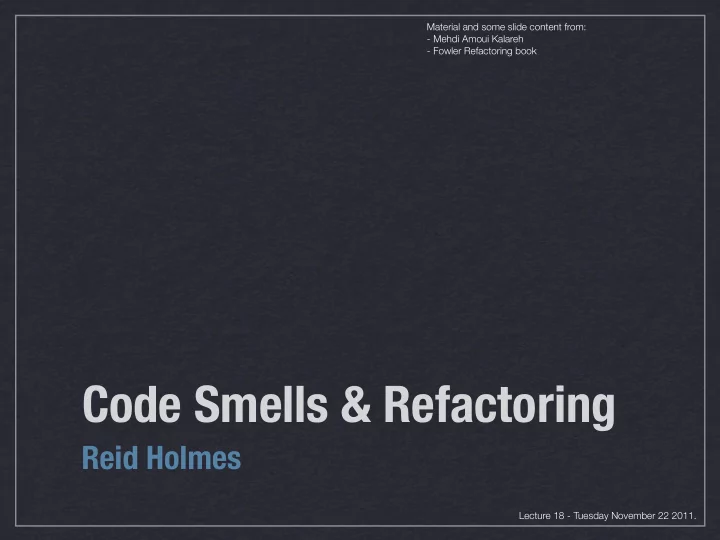

Material and some slide content from: - Mehdi Amoui Kalareh - Fowler Refactoring book Code Smells & Refactoring Reid Holmes Lecture 18 - Tuesday November 22 2011.
Program restructuring ‣ Software systems represent massive investments. ‣ To maintain their value, systems must evolve. ‣ The majority (>75%) of software development takes place on existing systems. ‣ Software maintenance / evolution comprises the largest proportion of a system’s total budget. ‣ Systems are modified to: ‣ Fix defects. ‣ Add new features. ‣ Support environmental changes. REID HOLMES - SE2: SOFTWARE DESIGN & ARCHITECTURE
Reasons for change ‣ Corrective: ‣ Adaptive: ‣ Perfective: ‣ Preventative: (% from SE Matinenance, Hans van Vilet) REID HOLMES - SE2: SOFTWARE DESIGN & ARCHITECTURE
Reducing change frequency ‣ Higher quality --> less maintenance ‣ Predicting changes --> less maintenance ‣ Better requirements --> less maintenance ‣ Less code --> less maintenance ‣ Regularly perform preventative maintenance REID HOLMES - SE2: SOFTWARE DESIGN & ARCHITECTURE
Lehman’s Laws ‣ Belady & Lehman proposed 8 laws of software evolution (beginning in 1974) ‣ #1 - Systems must evolve ‣ #2 - Systems will become increasingly complex ‣ #6 - Systems must gain new functionality ‣ Lehman’s advice: ‣ Complexity must be managed ‣ Systems must be periodically redesigned and refined ‣ System and development process is a feedback loop REID HOLMES - SE2: SOFTWARE DESIGN & ARCHITECTURE
Why is maintenance hard? ‣ Unstructured and complex code ‣ Low quality ‣ Poor initial design ‣ Lack of preventative maintenance ‣ Insufficient domain knowledge ‣ Change requests push original design ‣ Insufficient / stale documentation REID HOLMES - SE2: SOFTWARE DESIGN & ARCHITECTURE
Code smells ‣ Symptoms that hint at deeper problems ‣ Can also be considered anti-patterns ‣ Five core groups of smells: ‣ Bloaters: size becomes overwhelming ‣ long method, large class, prim. obsession, long param list, data clump ‣ OO abusers: OO design not leveraged ‣ switch statements, temp field, refused bequest, classes w/ similar interfaces ‣ Change preventers: Hinder further evolution ‣ divergent change, shotgun surgery, parallel inheritance hierarchy ‣ Dispensables: Unnecessary complexity ‣ lazy class, data class, duplicate code, dead code, speculative generality ‣ Couplers: Unnecessary coupling ‣ feature envy, inappropriate intimacy, message chains, middle man REID HOLMES - SE2: SOFTWARE DESIGN & ARCHITECTURE
Removing smells ‣ Using refactoring; 3 main steps: ‣ Understand ‣ Transform ‣ Refine ‣ Program behaviour should be unchanged ‣ Appropriate testing is crucial ‣ Refactorings happen in small steps ‣ Test at each step to make sure everything works REID HOLMES - SE2: SOFTWARE DESIGN & ARCHITECTURE
Refactoring ‣ Should happen as you learn better techniques ‣ Rule of threes: ‣ 1) Code it up ‣ 2) Code it again (but wince) ‣ 3) Refactor REID HOLMES - SE2: SOFTWARE DESIGN & ARCHITECTURE
OO abuser: switch ‣ class Animal { final int MAMMAL = 0, BIRD = 1, REPTILE = 2; int myKind; // set in constructor ... String getSkin() { BEFORE switch (myKind) { case MAMMAL: return "hair"; case BIRD: return "feathers"; case REPTILE: return "scales"; [adding Insect is easy] default: return "integument"; } [subclasses probably differ] } } [avoid other switches] ‣ class Animal { String getSkin() { return "integument"; } } class Mammal extends Animal { String getSkin() { return "hair"; } AFTER } class Bird extends Animal { String getSkin() { return "feathers"; } } class Reptile extends Animal { String getSkin() { return "scales"; } } REID HOLMES - SE2: SOFTWARE DESIGN & ARCHITECTURE
Speculative generality example STRATEGY ABSTRACT FACTORY SINGLETON REID HOLMES - SE2: SOFTWARE DESIGN & ARCHITECTURE
Bloater: long method REID HOLMES - SE2: SOFTWARE DESIGN & ARCHITECTURE
Dispensables: duplicate code ‣ Template method can reduce duplicate code. ‣ Consider two fish: ‣ Big fish randomly move anywhere ‣ Little fish move anywhere except where big fish are. Fish << abstract >> move() BigFish LittleFish move() move() REID HOLMES - SE2: SOFTWARE DESIGN & ARCHITECTURE
Fish example General outline of the method: public void move() { choose a random direction; // same for both find the location in that direction; // same for both check if it’s ok to move there; // different if it’s ok, make the move; // same for both } Solution: Extract the check on whether it’s ok to move In the Fish class, put the actual (template) move() method Create an abstract okToMove() method in the Fish class Implement okToMove() in each subclass REID HOLMES - SE2: SOFTWARE DESIGN & ARCHITECTURE
Fish example ‣ Use a template to vary specific detail without duplicating code. • Note%how%this%works:% Fish When%a% BigFish %tries% << abstract >> move() to%move,%it%uses%the% move() %method%in% BigFish LittleFish Fish % move() move() • But%the% move() method%in% Fish %uses% the% okToMove(locn) Fish method%in% BigFish move() • And%similarly%for% << abstract >> okToMove(locn):boolean LittleFish % BigFish BigFish okToMove(locn):boolean okToMove(locn):boolean REID HOLMES - SE2: SOFTWARE DESIGN & ARCHITECTURE
Recommend
More recommend